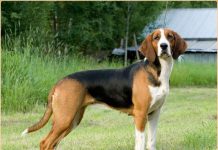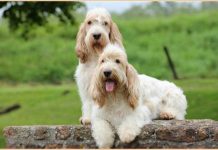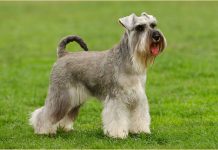The “African wild dog” also known as hunting dog is a very rare species in Africa. It is a vanishing species in east Africa. Like most social animal this wild dog is also very intelligent and sharp doing reflexes. Similar to most predators it also helps in eliminating below par and scrawny animals. Thus it helps to uphold a natural poise and in chorus improving the quarry variety.
Also read:
Introduction
“African wild dog” is scientifically known as “Lycaon pictus” which is a canid found only in Africa. It is then called the African wild dog, African hunting dog, Cape Hunting dog, painted dog etc. The scientific name is derived from Greek word for “wolf” and the Latin word for “painted”.
It is the only canid which is not having dewclaws in its forelimb. Again it is the largest canid in Africa and before the grey wolf becomes second largest wild canid in world. The scientific classification includes this species into “class-mammal”, “phylum-chordata” and “kingdom-Animalia”.
The adults typically weigh around 18 to 36 kilograms. It arises about 75 cm at the shoulder and the remaining body length up to 75-141 cm. The tail appends up to 30 to 45 cm. There are five subspecies of this wild dog. It is only extant species belongs to genus “Lycaon”. In relation with dogs, wolves and coyotes wild dogs are very close as far as other canids are concerned.
Previously these were speeded over sub Sahara Africa. Now days the most population found in three countries named as Namibia, Botswana and Zimbabwe. Due to the itinerant nature of these species it is hard to find out their exact population.
Appearance
The features of the African wild dog are thought to be quite distinctive. This wild dog is long legged having massive jaws, flat ears. It has got four toes instead of five which resembles in domestic dogs. The texture for this dog reflects a colourful coat of brown, black and yellow patches means “painted wolf.
Diet
African wild dog hunts in packs by making a small group. Like most member of the dog family the chase continues to a long period of time. They generally hunt in the early morning and late evening. They prey upon gazelles, antelopes, wildebeests, calves and rats.
The most common hunt depends upon the domestic availability and season. To hunt a larger prey they pass a coordinated approach. In this hunting process one dog catches the victim’s tail and other gets the lip, nose and head. Finally the other pack slaughters the animal.
Breeding
The centre pack of six dogs makes a breeding pair and several others to help known as no breeding adults. Similarly one female in the pack will form the subsequent breeding pair with any of the males.
A breeding female gives birth once in a year. The average for the breeding is nearly about ten pups. The pups are born in a shelter, thick grass or may be in a hole. Unlike many others, the female brood left the place after mellowness. The hunting members reunion from their prey by then giving nourishment to the pups and female offspring.
But some of them die from exposure and diseases. Therefore the hunting team is reduced the efficiency of getting food becomes difficult. Social behaviour of the “wild dogs” is comprised of related males and females. Accordingly they will form a pack. If any of the group do not merge then they will be separated and join another masculinity group.
Predators
The African wild dog becomes an endangered species due to habitat loss and forest encroachment. It is basically having a competition with the carnivores that they have been looking for, like the lions and hyena. Lions often kill as many as they can while chasing but do not eat them. Again throughout the Africa the wild dogs have been killed by farmers. Due to this region they become more brisk and vivacious. In some areas they are seal to annihilation.
Facts and Figures
The distribution of “wild dog” is in relation with where they are living. Often it counts one dog in every 208 square kilometres in Serengeti which contradicts with 1 dog per 25 square kilometres. At one point, there were 500,000 African wild dogs spread across 39 countries. Now there are only 3000 to 5500 species remain left behind.
Life Cycle and life Style
“African Wild dog” may reproduce once in a year. It may happen during the zenith between March and June logically. The copulatory characteristics of mates found to be less that is less than a minute. The time between the births is 10-14 minutes. The litters may contain 2-19 new ones. The typical gestation period is of 70 days. Pups are usually born in dens and then removed by the group. After three months the pups run off the burrow and began to sprint with the cluster.
The African wild dog is highly social, often found in large, tight-knit packs. There is a strict ranking within the system which is headed by a strict leader. They undergo with a good responsibility and do everything as a group whether it may be giving food, giving assistance to the young ones and also going for a hunt. These facts clearly resemble that “African wild dogs” pilot a superior lifestyle.
Also read:
Habitat
“African wild dog” is mostly set up in arid zones and also in savanna. During their quarry they are also found in forest and heap habitats. They choose to make their set up in shades, bushes to feel relaxed and to have rest.
Images, Pics, Photos and Pictures of African Wild Dog :
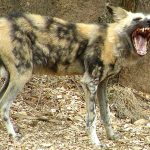
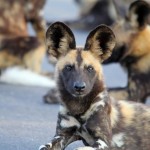


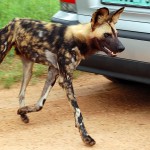
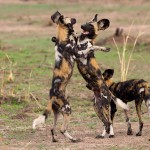
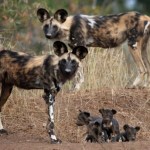
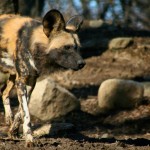

Behaviour
This “African wild dog” exists in a cluster of six to twenty. The dogs have a ignition bonding between them which helps to commence each hunt. They start circulating among the members and whispering, poignant in anticipation as they are ready for the hunt. The attack for the prey is coordinated, designed, well planned and in a cooperative manner. They can sprint distances up and about 35 miles per hour.


